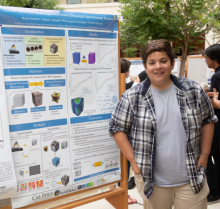
Major:
University:
Mentor(s):
Faculty Sponsor(s):
Faculty Sponsor's Department(s):
Project Title:
Project Description:
Additive manufacturing (AM) is a new, highly desirable manufacturing technique due to its ability to quickly produce components not possible with traditional methods. With decreased limits on manufacturing speed and component geometry comes a possible decrease in material quality; at their current stage, AM components have more potentially compromising internal defects than their traditionally manufactured counterparts. A non-destructive evaluation (NDE) method is needed to ensure AM component quality by detecting internal material defects. Resonant ultrasound spectroscopy (RUS) is a promising candidate for its simple experimental apparatus, low test duration and sensitivity to microstructure. Predicting AM component material structure from RUS response requires a framework quantifying the effects of common AM defects, such as porosity, inclusions and texture deviations on a material’s RUS response. This study is conducted on Inconel 718, a printable nickel-based superalloy used for its strength, fatigue life and corrosion resistance. A finite element model was created to predict the response of a polycrystalline component with given microstructural features including pores, inclusions and texture. Several homogenization techniques were employed to replace the complex polycrystalline structure with a homogenized structure with the same elastic properties, reducing computational requirements for RUS simulation at the component length scale. The resulting framework allows modeling RUS response accounting for the microstructure. Tests on samples of varying texture were run and their RUS responses compared to simulated versions. Simple homogenization methods were able to replicate the response trends of experimental data. More complex homogenization methods will be employed to better match the responses.
